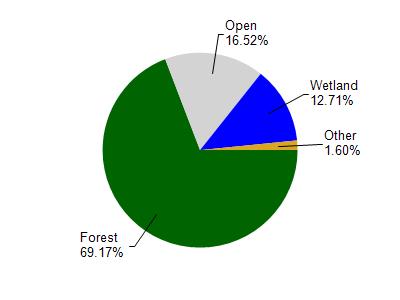Sawyer
No
No
No
Fish and Aquatic Life
Overview
Mud Lake, in the Lake Chippewa Watershed, is a 463.62 acre lake that falls in Sawyer County. This lake is managed for fishing and swimming and is currently considered impaired.
Date 2011
Author Aquatic Biologist
Historical Description
Source: 1969, Surface Water Resources of Sawyer County
Mud Lake, T41N, R7W, Section 27,28,33,34
Surface Acres = 388.6, Maximum Depth = 14 feet, M.P.A. = 40 ppm,
Secchi Disk = 7 feet
A soft water, drainage lake on the North Fork of the Chief
River. It has an estimated normal outlet flow of 10 cubic feet per
second. The two-foot impounding structure on nearby Callahan Lake
also impounds the water of Mud Lake. The fish population includes
muskellunge, walleye, largemouth bass, bluegill, black crappie,
pumpkinseed, perch, rock bass, bullheads, and suckers. Although
the shoreline is predominately upland, the irregular shape of the
lake with its numerous bays, islands, and floating bogs appears to
predominate. Much of the lake has depths of less than six feet and
rooted aquatic vegetations such as cattails, spike rushes,
bulrushes, bur reed, and floating pond weed are common, providing
extensive nesting habitat for waterfowl. Muskrat and beaver are
also common, Private development amounts to only two cottages. The
only access is by water from Callahan Lake. Of the lake's 6.35
miles of shoreline, 0.65 miles is in state ownership as part of a
remnant warmwater fish habitat project.
Date 1969
Author Surface Water Inventory Of Wisconsin
Condition
Wisconsin has over 84,000 miles of streams, 15,000 lakes and milllions of acres of wetlands. Assessing the condition of this vast amount of water is challenging. The state's water monitoring program uses a media-based, cross-program approach to analyze water condition. An updated monitoring strategy (2015-2020) is now available. Compliance with Clean Water Act fishable, swimmable standards are located in the Executive Summary of Water Condition in 2018. See also the 'monitoring and projects' tab.
Reports
Recommendations
Management Goals
Wisconsin's Water Quality Standards provide qualitative and quantitative goals for waters that are protective of Fishable, Swimmable conditions [Learn more]. Waters that do not meet water quality standards are considered impaired and restoration actions are planned and carried out until the water is once again fishable and swimmable
Management goals can include creation or implementation of a Total Maximum Daily Load analysis, a Nine Key Element Plan, or other restoration work, education and outreach and more. If specific recommendations exist for this water, they will be displayed below online.
Monitoring
Monitoring the condition of a river, stream, or lake includes gathering physical, chemical, biological, and habitat data. Comprehensive studies often gather all these parameters in great detail, while lighter assessment events will involve sampling physical, chemical and biological data such as macroinvertebrates. Aquatic macroinvertebrates and fish communities integrate watershed or catchment condition, providing great insight into overall ecosystem health. Chemical and habitat parameters tell researchers more about human induced problems including contaminated runoff, point source dischargers, or habitat issues that foster or limit the potential of aquatic communities to thrive in a given area. Wisconsin's Water Monitoring Strategy was recenty updated.
Grants and Management Projects
Monitoring Projects
| WBIC | Official Waterbody Name | Station ID | Station Name | Earliest Fieldwork Date | Latest Fieldwork Date | View Station | View Data |
|---|
| 2434800 | Mud Lake | 583216 | Mud Lake - Deepest Spot | 8/7/2007 | 8/3/2025 | Map | Data |
| 2434800 | Mud Lake | 10018094 | Mud Lake -- Chief River Public Access | 7/30/2010 | 7/31/2011 | Map | Data |
| 2434800 | Mud Lake | 10005656 | Mud Lake | 9/5/2000 | 9/12/2017 | Map | Data |
|

Watershed Characteristics
Mud Lake is located in the Lake Chippewa watershed which is 182.90 mi². Land use in the watershed is primarily forest (69.10%), open (16.50%) and a mix of wetland (12.70%) and other uses (1.60%). This watershed has 117.68 stream miles, 4,827.59 lake acres and 14,304.38 wetland acres.
Nonpoint Source Characteristics
This watershed is ranked Low for runoff impacts on streams, Low for runoff impacts on lakes and Low for runoff impacts on groundwater and therefore has an overall rank of Low. This value can be used in ranking the watershed or individual waterbodies for grant funding under state and county programs.However, all waters are affected by diffuse pollutant sources regardless of initial water quality. Applications for specific runoff projects under state or county grant programs may be pursued. For more information, go to surface water program grants.